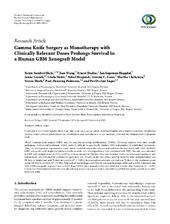| dc.contributor.author | Skeie, Bente Sandvei | en_US |
| dc.contributor.author | Wang, Jian | en_US |
| dc.contributor.author | Dodoo, Ernest | en_US |
| dc.contributor.author | Heggdal, Jan Ingemann | en_US |
| dc.contributor.author | Grønli, Janne | en_US |
| dc.contributor.author | Sleire, Linda | en_US |
| dc.contributor.author | Bragstad, Sidsel Marit | en_US |
| dc.contributor.author | Ganz, Jeremy Christopher | en_US |
| dc.contributor.author | Chekenya, Martha | en_US |
| dc.contributor.author | Mørk, Sverre | en_US |
| dc.contributor.author | Pedersen, Paal-Henning | en_US |
| dc.contributor.author | Enger, Per Øyvind | en_US |
| dc.date.accessioned | 2015-04-14T13:08:10Z | |
| dc.date.available | 2015-04-14T13:08:10Z | |
| dc.date.issued | 2013 | eng |
| dc.identifier.issn | 0388-6107 | |
| dc.identifier.uri | https://hdl.handle.net/1956/9781 | |
| dc.description.abstract | Object. Gamma knife surgery (GKS) may be used for recurring glioblastomas (GBMs). However, patients have then usually undergone multimodal treatment, which makes it difficult to specifically validate GKS independent of established treatments. Thus, we developed an experimental brain tumor model to assess the efficacy and radiotoxicity associated with GKS. Methods. GBM xenografts were implanted intracerebrally in nude rats, and engraftment was confirmed with MRI. The rats were allocated to GKS, with margin doses of 12Gy or 18Gy, or to no treatment. Survival time was recorded, tumor sections were examined, and radiotoxicity was evaluated in a behavioral open field test. Results. In the first series, survival from the time of implantation was 96 days in treated rats and 72 days in controls (𝑃 < 0.001). In a second experiment, survival was 72 days in the treatment group versus 54 days in controls (𝑃 < 0.006). Polynuclear macrophages and fibrosis was seen in groups subjected to GKS. Untreated rats with GBM xenografts displayed less mobility than GKS-treated animals in the open field test 4 weeks after treatment (𝑃 = 0.04). Conclusion.GKS administered with clinically relevant doses prolongs survival in rats harboringGBMxenografts, and the associated toxicity is mild. | en_US |
| dc.language.iso | eng | eng |
| dc.publisher | Hindawi | eng |
| dc.rights | Attribution CC BY | eng |
| dc.rights.uri | http://creativecommons.org/licenses/by/3.0/ | eng |
| dc.title | Gamma knife surgery as monotherapy with clinically relevant doses prolongs survival in a Human GBM Xenograft Model | en_US |
| dc.type | Peer reviewed | |
| dc.type | Journal article | |
| dc.date.updated | 2015-04-01T09:13:40Z | en_US |
| dc.description.version | publishedVersion | en_US |
| dc.rights.holder | Copyright 2013 Bente Sandvei Skeie et al. | |
| dc.source.articlenumber | 139674 | |
| dc.identifier.doi | https://doi.org/10.1155/2013/139674 | |
| dc.identifier.cristin | 1096273 | |
| dc.source.journal | Biomedical research | |
| dc.source.40 | 2013 | |
| dc.subject.nsi | VDP::Medical sciences: 700::Clinical medical sciences: 750::Neurosurgery: 786 | eng |
| dc.subject.nsi | VDP::Medical sciences: 700::Clinical medical sciences: 750::Oncology: 762 | eng |
| dc.subject.nsi | VDP::Medisinske fag: 700::Klinisk medisinske fag: 750::Nevrokirurgi: 786 | nob |
| dc.subject.nsi | VDP::Medisinske fag: 700::Klinisk medisinske fag: 750::Onkologi: 762 | nob |

